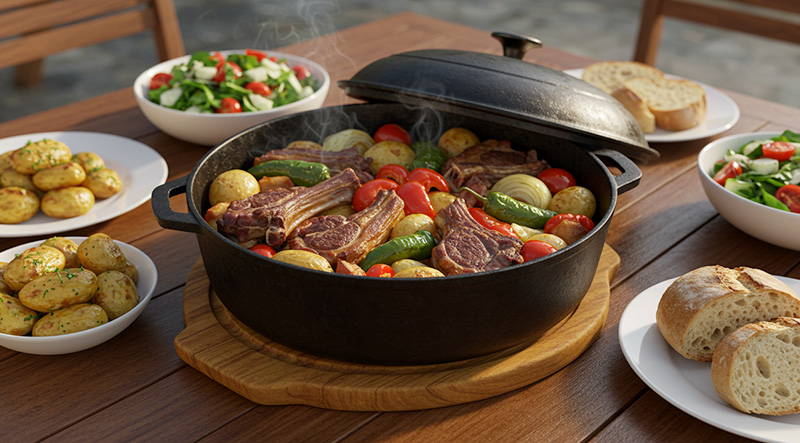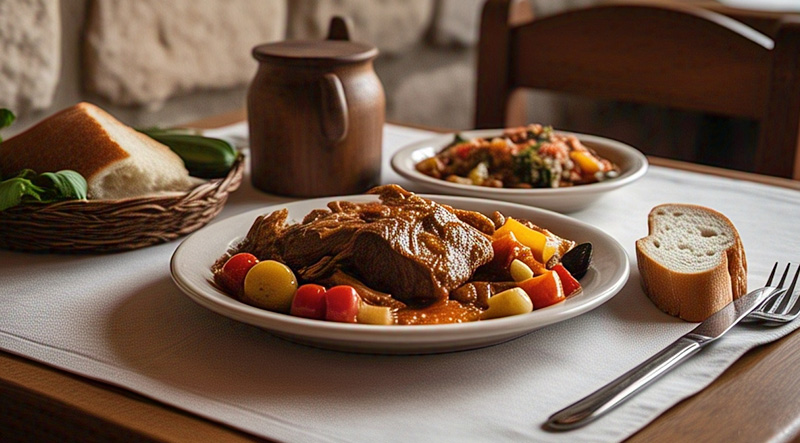Beneath a dome of glowing embers, magic happens—Peka, Croatia’s national culinary masterpiece, is a slow-cooked wonder that captures the essence of Dalmatian tradition. Picture tender chunks of veal, lamb, or octopus, roasted to perfection alongside golden potatoes, sweet carrots, and aromatic garlic, all infused with smoky herbs and the soul of the fire. Cooked ispod peke—under a bell-shaped lid covered in hot coals—this dish isn’t just food; it’s a celebration of patience, flavor, and heritage. Rustic, rich, and mouthwateringly savory, Peka is the kind of meal that turns a simple gathering into an unforgettable feast. Read More...
The History of Peka – Croatia’s Slow-Cooked Culinary Treasure:
In the sun-kissed lands of Croatia, where stone villages overlook the shimmering Adriatic Sea, culinary tradition is both a ritual and a form of storytelling. Among its most treasured dishes, Peka—also known as ispod peke—stands as a proud symbol of Croatian heritage, especially along the Dalmatian coast. But this rustic delicacy is more than just a meal; it’s a flavorful reflection of centuries-old customs, fire-side craftsmanship, and the deep connection between food, family, and nature.
What Is Peka?
At its core, Peka is a dish of meat—often veal, lamb, or octopus—slow-cooked with potatoes, onions, carrots, garlic, and Mediterranean herbs under a bell-shaped dome lid called a peka. This dome is placed over a shallow tray of food and buried in hot coals, where it stews and roasts simultaneously, locking in smoky, juicy flavors and tender textures.
But the magic of Peka doesn’t just lie in the ingredients—it lies in the process. The technique requires skill, patience, and tradition, often passed down through generations.
Ancient Roots in the Hearth:
The origins of Peka trace back to ancient times when open-fire cooking was central to daily life. While exact historical records are scarce, the concept of burying food under hot embers has been used throughout the Mediterranean, the Balkans, and even North Africa for millennia. In Croatia, this method evolved into a uniquely local art form, influenced by the country’s blend of Slavic, Roman, Ottoman, and Venetian culinary heritage.
During the Ottoman era, similar techniques using metal or clay lids were common in rural households. Over time, Croatians developed their own variant, embracing the use of the heavy iron or ceramic čripnja (the peka lid) and seasoning ingredients with the herbs and oils of the Dalmatian coast.
A Dish of Family and Festivity:
In Croatian culture, Peka is not an everyday meal—it’s a celebration dish, often reserved for Sunday lunches, weddings, holidays, or gatherings of friends and extended family. Preparing it takes hours and is typically done outdoors in stone ovens or open fire pits, turning the act of cooking into a social and ceremonial event.
Villagers and coastal towns take pride in their own family versions of Peka, with each household adding a personal touch—perhaps a splash of white wine, a handful of rosemary, or a side of homemade bread and olive oil. Some even use seafood, like cuttlefish or squid, especially in the Dalmatian islands.
From Local Treasure to Global Recognition:
As Croatia gained global recognition for its natural beauty and tourism, Peka followed close behind as a gastronomic ambassador. Travelers often experience it in rustic taverns or konobas, where the dish is lovingly prepared in wood-fired ovens with a glass of local wine on the side. In fact, many visitors now seek out Peka as a must-try culinary adventure—often needing to order it a day in advance due to its slow-cooked nature.
Peka Today:
In the age of fast food and high-speed cooking, Peka remains refreshingly slow, deliberate, and rooted in tradition. Whether cooked in a mountain village or served in a seaside restaurant, Peka continues to bring people together around the fire—just as it has for generations.
In the end, Peka is more than a dish—it’s a timeless ritual. It speaks of heritage, hospitality, and the rich flavors of the Croatian land and sea, all brought together under a dome of glowing embers and shared with those you love.

If Using an Oven (Home-Style Peka):

If Using a Traditional Peka (Outdoor Fire Pit):

Tips:
The total preparation and cooking time for Peka is approximately 2.5 to 3 hours. This includes about 30 to 40 minutes of preparation, such as chopping vegetables, marinating or seasoning the meat, and assembling the ingredients in the pan. The cooking time ranges from 2 to 2.5 hours, depending on the type and cut of meat used, as well as whether you're using a traditional peka dome over coals or a home oven. For seafood versions like octopus, the cooking time may be closer to 1.5 hours.
A single serving of Peka, based on the provided recipe using veal or lamb, potatoes, carrots, olive oil, and wine, contains approximately 600 to 750 calories. This estimate includes a moderate portion of meat (about 200g), a generous helping of potatoes and vegetables, and the use of olive oil for roasting. The calorie count can vary depending on the cut of meat and amount of oil used. Seafood versions like octopus may be slightly lower in calories (around 500–600), while fattier cuts of lamb or additional sides like bread or wine can push the total higher.







